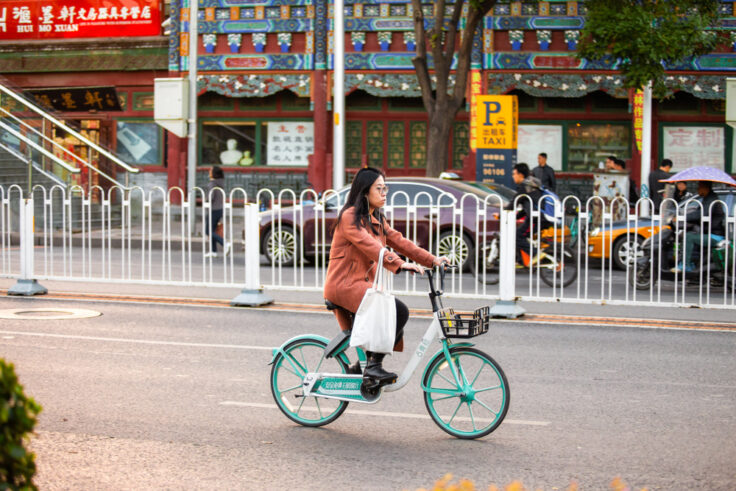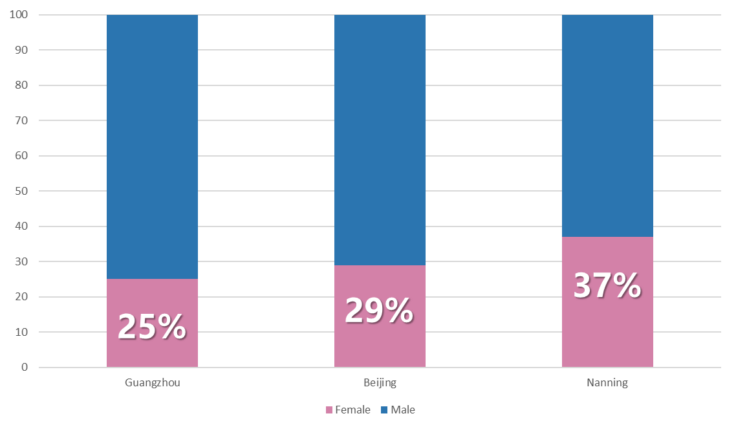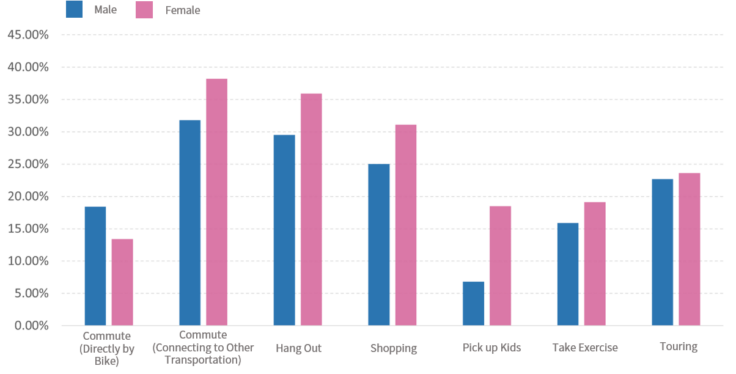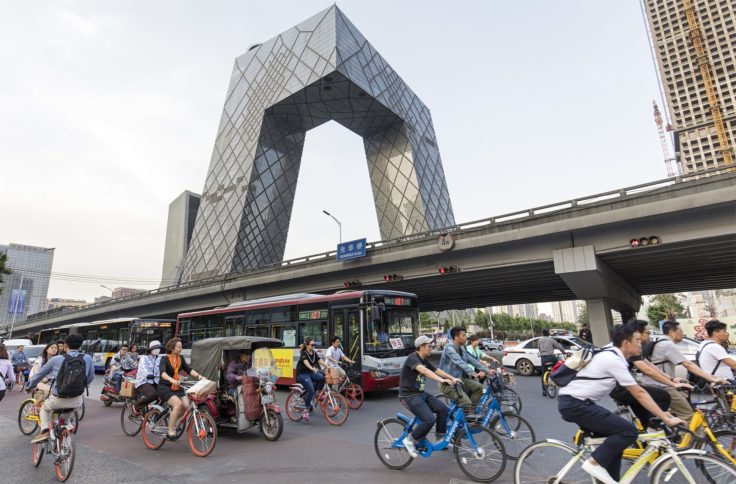March 08, 2023
Exploring the Cycling Gender Gap in China’s Cities
We know that there persists a gender gap in cycling that prevents women and girls from choosing cycling as a primary transport mode in many regions of the world. On International Women’s Day 2023, ITDP China released a new report that provides a look at the state of women cyclists in several major Chinese cities, drawing on in-depth surveys, cycling counts, and other research.
Through Cycling Cities, ITDP and our cohort partners are committed to making cycling more accessible, inclusive, and safer for millions of people.
In many cities, the bicycle can be an instrument of personal freedom and empowerment for women and girls. Access to cycling provides many women with mobility options that allow them to move more efficiently, affordably, and securely than other modes of transport, particularly in regions without comprehensive public transit. In the words of famed women’s rights activist and social reformer Susan B. Anthony in 1896: “The bicycle has done more to emancipate women than any one thing in the world… it gives her a feeling of self-reliance and independence the moment she takes her seat.”
Nevertheless, even in today’s modern world, a persistent gender gap exists in cycling in many global cities, a gap that has been exacerbated by a number of social, economic, and cultural factors that continue to prevent women, girls, and gender non-conforming groups from cycling in the same numbers as their cisgender male counterparts. Through ITDP’s ongoing work around the world on sustainable, active mobility policies and interventions, we continue to gather on-the-ground data on issues related to gender equity across transport modes to provide key insights for urban decision-makers seeking to promote safer, more accessible cycling for all communities.
In ITDP China’s latest report, Women On Wheels, the team utilized cycling counts, direct surveys, and other outreach methods over two years (2021-2022) to assess the state of women cyclists in three major cities and to offer key recommendations for improving street conditions — not only for women on wheels, but for all cyclists and pedestrians. The team specifically studied Beijing and Guangzhou, as major cities with variety in their cycling facilities, and Nanning, as the city with the highest number of e-bikes in the country.

Through volume counts at 45 locations within these cities, ITDP China found that less than 30% of the cyclists on the road were women. This rate of women cyclists is fairly consistent with many cities and countries where the mode share of trips taken by bike is low overall (less than 10%) for both men and women. To explore the challenges, and opportunities, for encouraging more women to cycle in these cities, ITDP China collected data through more than 400 self-conducted surveys and individual interviews from women from diverse demographics. The findings revealed that Guangzhou had the least percentage of women cycling at 25%, while Nanning had the most at 37%, numbers that correlate with the comprehensiveness of each city’s cycling infrastructure.


Factors that may contribute to the gender disparity in these three cities include topography and climate, the varying conditions of bike lanes and related facilities, and the perceived safety of city streets where vehicles are dominant. The report finds that the majority of the roads in Guangzhou’s central districts were designed and constructed with a focus on cars and vehicle traffic, resulting in narrower non-motorized lanes which directly impacts the safety, comfort, and air quality experienced by cyclists. In Beijing and Nanning, which both have more extensive networks of bike lanes and more inclusive street infrastructure, the amount of women cyclists observed were notably higher. In Nanning, many of the main thoroughfares and roads in the city center have auxiliary lanes that limit vehicle speeds and ease congestion, alongside dedicated bike lanes to accommodate the large number e-bike riders in the city.
In order to encourage more women to choose cycling, and to make it easier for them to do so, city planning and policies should reflect the daily activities and social roles of women. We know that women and caregivers have unique mobility needs in cities and often require multiple stops to accomplish a series of tasks during a single trip, such as commuting to work, grocery shopping, picking up children, and more. Riding a bike can sometimes be the most efficient, accessible, and affordable way for women to complete these daily activities, yet challenges of access and safety prevent many from doing so. As Women On Wheels reveals, women in the three Chinese cities are less likely to make direct work commutes by cycling, possibly because of the variety of stops they need to make, but are more likely than men to rely on cycling as a means of accessing leisure, exercise, errands, and for multi-modal trips. Thus, it is crucial that cities implement street and space designs, alongside supportive policies, that make both small neighborhoods and large central districts more responsive to diverse types of cycling commutes.

One way to do this is to focus on creating and implementing safe, high-quality cycling infrastructure. Across all three cities, surveys indicated that women showed a clear priority for safety in their cycling environments — protected, dedicated bike lanes were favored by women across road conditions and are more likely to encourage more to choose cycling for travel. We also know that networks of protected bike lanes, particularly in low- and middle-income countries, offer a number of economic, social, and climate benefits overall. A safer and more protected urban cycling environment has been shown to lead to significant upticks in cycling mode share overall, all around the world. The consensus among women cyclists in the three cities demonstrates that road safety should be a top consideration for local policymakers. This is particularly evident in Guangzhou, where cycling infrastructure is the least comprehensive of the three cities, which produced noticeably fewer women on bikes in ITDP China’s surveys.

These concerns with road safety are validated by studies that show that women can be at higher risks for vehicle accidents while cycling on roads, compared to men, without physical barriers like protected bike lanes, bollards, and greenways. But this is certainly not an insurmountable obstacle; in cities and countries where there has been comprehensive investment into quality cycling infrastructure and traffic reduction interventions (like in Denmark and the Netherlands), the percentage of women cyclists can grow to be 50% or even higher. In most other regions, however, in order to bridge this gender cycling gap it is crucial that we begin to plan and re-design streets that adapt to the needs of all cyclists and pedestrians.
A further key finding from Women On Wheels is that access to bikeshare systems and electric two-wheelers (or e-bikes) can significantly increase the percentage of women riders in these Chinese cities. Due in part to their accessibility and affordability, there has been growing demand for bikeshare systems and e-bikes or mopeds across China, a momentum that offers significant potential to shift people away from driving towards cycling. Local research in Guangzhou has shown that the proportion of women who use bikeshare can be nearly seven times that of men. As the number of bike riders increase, bikeshare providers have also introduced inclusion measures, such as model optimization to improve the riding experiences for women, which will hopefully lead to further usage and uptake.

Ultimately, the global gender disparity in cycling is indicative of broader challenges of transport-based gender inequality and bias in urban mobility systems. This is clear in city after city, particular in low- and middle-income countries. For instance, in Kisumu, Kenya, 96% of cyclists are men compared to only 4% of women; in Rio de Janeiro, Brazil, the proportion of women cyclists ranged from just 2.4% to 10.9%; and in Delhi, India women riders constituted only 2% of cycling trips. These disparities reflect larger issues such as an unequal access to bicycles in childhood, personal and road safety concerns on city streets, and a lack of consideration for women’s travel patterns in urban planning. Addressing these issues requires a systems-level approach, one that ensures that cycling facilities, infrastructure investments, and mobility policies in our cities are made with the needs of women, girls, and marginalized communities top-of-mind.
Download ITDP China’s Women On Wheels report for more findings and recommendations for improving cycling infrastructure in Chinese cities and beyond.
